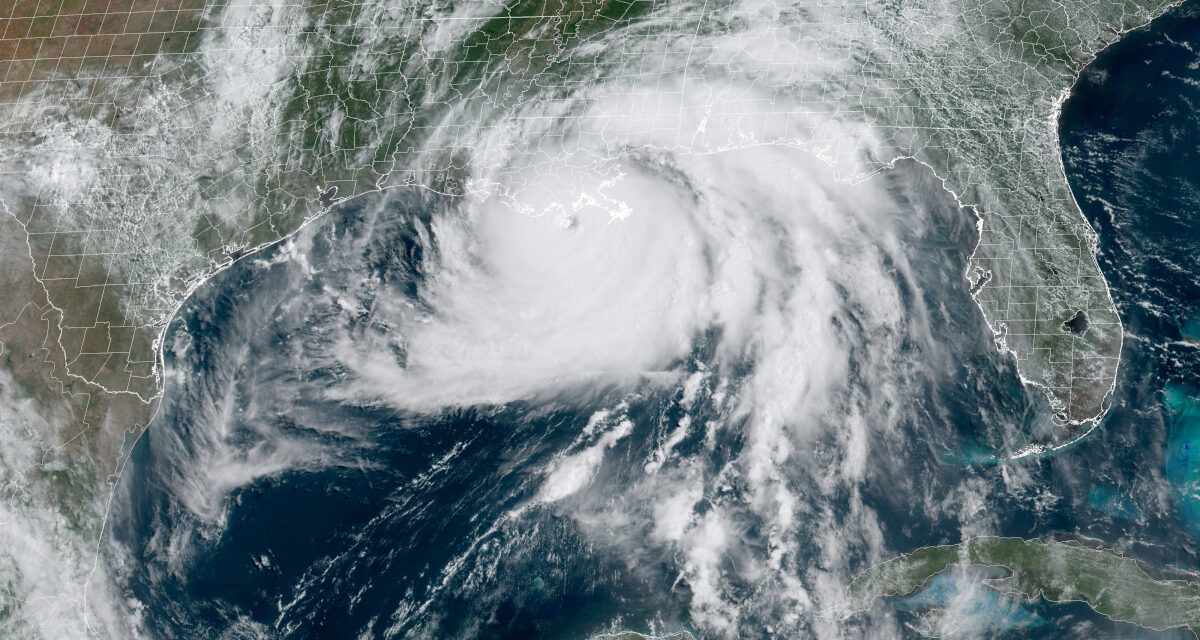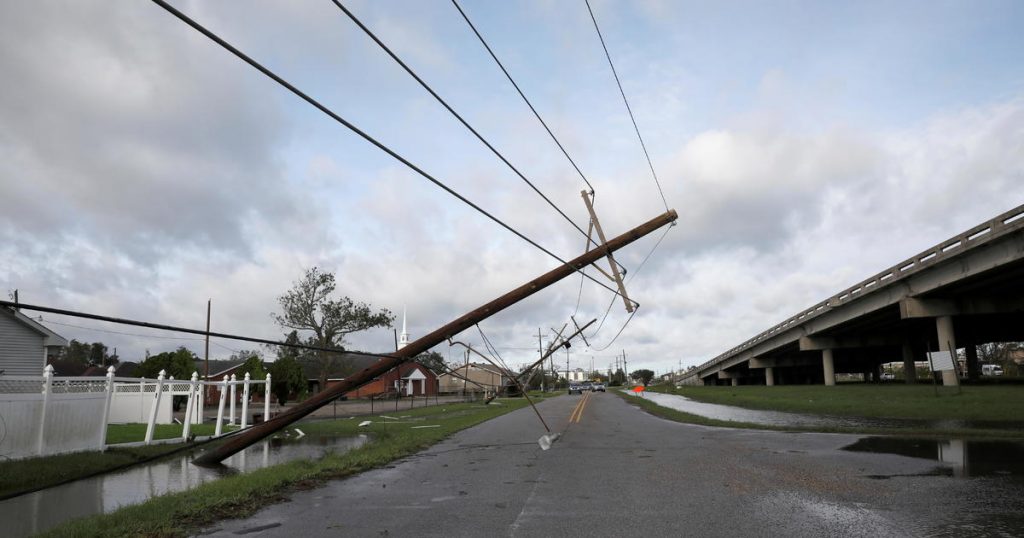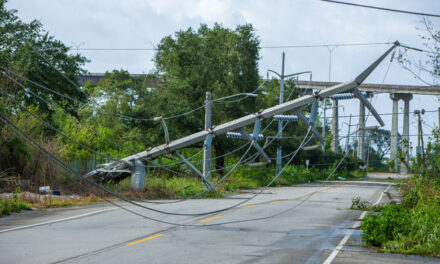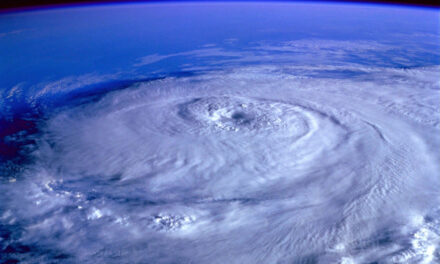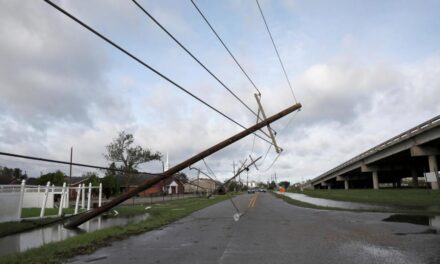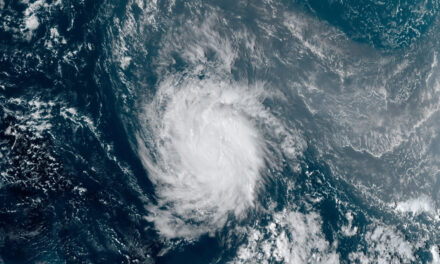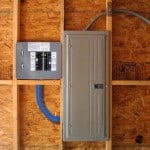Hurricane Ida at 10:40 am, about 80 minutes before it made landfall on Louisiana at Port Fourchon with 150 MPH wind. NOAA Satellite Imagery.
16-Foot Storm Surge and Saturated Ground May have Delayed Weakening
Louisiana, August 30, 2021: Hurricane Ida made landfall at Port Fourchon, Louisiana on Sunday August 29 about noon Central Time with sustained Winds of 150 MPH. A weather station recorded a wind gust 170 MPH. Ida brought a 12-16-foot storm surge ashore near the storm’s center with lessor amounts to the west and east. Instead of rapidly weakening as expected, Ida slowed down. With energy from its own storm surge and saturated soils, the storm maintained hurricane strength all the way to the Mississippi border. Ida was downgraded to a tropical storm about 3 A.M. this morning.
President Joe Biden declared Louisiana a disaster, opening the channels for federal aid money.
As of 10 A.M, over 1.1 utility customers in Louisiana and Mississippi remained without power as utility crews began assessing the damage.
Portable Generators for Home Use
Key messages from National Hurricane Center start with a warning that storm surge inundation will continue along Mississippi and Alabama Coasts into the afternoon. New Orleans, along with the Mississippi and Alabama coasts, remains within the wind field and under a tropical storm warning. Sustained winds above 40 MPH extend south, southeast, and east.
Ida’s storm surge temporarily reversed the flow of the Mississippi River.
Storm surge and strong winds from Hurricane Ida stopped the flow of the Mississippi River near New Orleans on Sunday and actually caused it to reverse -- something the US Geological Survey says is "extremely uncommon." https://t.co/SsGdybbU1F
— CNN (@CNN) August 30, 2021
Ida is tied for the fifth-strongest hurricane to ever hit the U.S. mainland.
— USA TODAY (@USATODAY) August 30, 2021
Photos show collapsed buildings, including destruction in the French Quarter, and more in the wake of the ongoing storm's dangerous winds. https://t.co/WzVIIrwY5O
????: AP, Getty Images pic.twitter.com/mwH8vxuFab
Hurricane Ida is seen by @Space_Station crew member @Thom_Astro, hours before the storm’s landfall in Louisiana.
— NASA (@NASA) August 29, 2021
Observing hurricanes from space helps us work with partner agencies like @NOAA and @FEMA to support preparation and disaster response: https://t.co/9Agx7JVn5O pic.twitter.com/cjLcAM1Z54
Hurricane Ida compared to Katrina
It was sixteen years ago that Hurricane Katrina made landfall as a category 3 storm, but it was much larger than Hurricane Ida. Katrina had a storm surge up to 28 feet, which overwhelmed the levee system and flooded New Orleans and the surrounding area. As a much smaller, but more powerful storm, Ida’s storm surge topped out at 12 to 16 feet. Most of the levee system did its job and kept the storm surge out. Katrina flooded about 80 percent of the city.
Kelli Chandler, regional director of the Southeast Louisiana Flood Protection Authority pointed out that New Orleans is better protected than ever before with stronger, higher levees.
Both storms were very destructive and will go down in history.
The comparison of Ida to Katrina makes another fact quite clear. Category strength and wind speed are insufficient to judge a storm. Sixteen years ago, Katrina made landfall at Category 3 with 125 MPH wind. Ida made landfall with 150 MPH wind. Both storms caused catastrophic wind damage. Though it had higher winds, Ida’s storm surge was much less than Katrina’s.
Hurricane Ida Damage
This morning, FEMA administrator Deanne Criswell mentioned “widespread structural damage” some of it significant, which included building collapses.
Criswell also said the local electric utility brought in at least 6000 crews to help restore power. The Army Corp of Engineers will provide generators for critical facilities that need power. All of southeastern Louisiana is without power this morning as the storm severed the primary transmission lines. The city is without 911 service this morning.
FEMA Recommends Backup Power Generator
Ida stayed at Category 4 strength much longer than expected with high winds, extended storm surge, and torrential rain, and therefore caused more damage. Criswell said, “This is going to be a really long recovery.”
After Katrina, we got a standby generator from Norwall. Then came Gustav and Ike and Delta, Zeta, and now Ida. It starts right up in the middle of the hurricane and we’ve got power thirty seconds after it went out. ~Facebook user
Some of the damage in downtown New Orleans. This was where the historic record store, the Karnofsky Shop, once stood - Louis Armstrong played jazz and briefly worked here. The whole city is still without power after #HurricaneIda pic.twitter.com/qIMVtwJmfy
— Sarah Gough (@sarahgoughy) August 30, 2021
Main Street in downtown #Houma after a direct hit by Hurricane #Ida pic.twitter.com/fer7wmBG7l
— Nick Wagner (@WagsPhoto) August 30, 2021
????
— Andre’ (@Thyrealandre) August 30, 2021
Artist: BMike#HurricaneIda pic.twitter.com/mJ7ZBSdV7O
Norwall Emergency and Disaster Preparedness Resources
There's a lot to do and not much time to do it. These checklists help you get it all done.
7 Hurricane Preparedness Checklists Not to Forget
Follow these tips to stay safe in any disaster from hurricanes to tornadoes to winter storms.
Emergency Preparedness Tips
When a disaster like a hurricane threatens, it's easy to get caught up in the news and their messages of impending doom. While it's important to stay informed, remember how to stay safe and prepared.
Disaster Preparedness: Things to Remember when Disaster Threatens
There are right ways and wrong ways to use a portable generator when the power goes out. Never use one indoors, for example.
How to Use a Portable Generator for Emergency Power
Carbon Monoxide Poisoning. Electrocution. Fires. Shocks. Burns. Follow these safety rules when using a portable generator to keep your family alive, safe, and healthy.
Portable Generator Safety Rules to Live By
It just makes sense. When a disaster strikes, the power could be out for days or even weeks. Following Hurricanes Katrina and Sandy, some utility customers went more than a month without power.
FEMA Recommends Backup Power Source for Emergency Preparedness
Get ahead of the storm with these
Top 10 Tips to Survive a Hurricane Disaster
Hurricane Preparedness starts with an assessment of the risks to your family and home based on where you live, how your home was built, and what your options might be during a hurricane.
Hurricanes Preparedness: Know Your Risks Make Your Plans
Put together your plans after you assess the risks. Then build disaster kits for your home, vehicles, and individual members of your family. Food and Water are important. So is a full tank of gas and an evacuation plan.
Hurricane Preparedness: Disaster Planning and Preparation
Is your home ready for the extreme winds and other hazards? You can reinforce your home's structure to help it survive a hurricane. Window and Door coverings will help keep the roof on.
Hurricane Preparedness: Prepare Your Home Against a Hurricane
You've assessed your risks. Made some plans. Built some kits. Your home is ready for nature's worst. Complete your hurricane preparedness disaster plan.
Hurricane Preparedness: Your Completed Disaster Preparation Plan
The time may come when authorities issues mandatory or voluntary evacuation orders. Voluntary orders may turn into mandatory orders. If you have a plan to evacuate when it's time to go, you won't spend precious minutes gathering items or figuring out a route or destination.
Hurricane Preparedness: Create a Home Emerergency Evacuation Plan
Electrical Power went from a convenience to a necessity in less than a century. A short power outage is no big deal, but a few hours without power makes life difficult and sometimes dangerous.
How to Prepare for a Power Outage
Winter weather can turn dangerous in a hurry. It doesn't even have to drop below freezing to become uncomfortable or deadly if you're not prepared.
Winter Weather Safety
Life is better when you're prepared with a plan and the items you need to survive when bad weather hits. From blizzards to ice storms, how you prepare ahead makes all the difference between living in comfort or struggling to survive.
Winter Emergency Preparedness Checklist

